The following is Part 1 of a 3-Part series reporting on the 26 presentations at the DirectEmployers (“DE”) Annual Meeting & Conference (DEAMcon24) of Members and the public. DE will publish the second installment on Wednesday, April 24, and the third installment on Monday, April 29.
The following are summaries and selected highlights from each of the extensive presentations.
Story references are to DE’s OFCCP Week in Review Blog.
DE Members may view the presentation slides for all the DEAMcon 2024 sessions at this link: https://deamcon.org/slides/
- DEAMcon24 Attendees Welcomed to the Big Easy for Three Days of Practical Insights, Networking & Merriment
- Member Spotlight: Aligning Compliance and Recruitment Efforts
- Ellis & Lewis Discussed Continuing the Focus on Diversity, Equity, Inclusion & Belonging While Facing Setbacks
- French Shared How Recruit Rooster’s Talent Attract App Helps Employers Navigate Veteran Recruitment & Retention
- Fox and Chambers Discussed OFCCP in Transition & What It Means for Federal Contractors
- Lewis & O’Hara-Harvey Explored the Equity Essentials
- Cappfinity Outlined Adoption and Conversion to a Skills-Based Employee Hiring and Development System
- Campbell Discussed Going Beyond Race & Gender to Create a More Equitable, Inclusive Culture
- The Walsh Group Explained the Nuts and Bolts of Starting a Veterans ERG Leveraged by DE’s Partner Relationship Tool
- Full Circle Compliance: Using DE Partnerships to Supercharge Recruitment & DEI Efforts
- Generational Expert Gwoke’s Keynote Focused on Recruiting & Retaining Millennial Employees
DEAMcon24 Attendees Welcomed to the Big Easy for Three Days of Practical Insights, Networking & Merriment

“Each year, we are incredibly grateful for the outpouring of support from our Members, partners, guests, and industry friends who choose to set aside time to attend this event,” Candee said. “We pride ourselves on community and our ability to connect everyone to forge new friendships, cement old connections, and reinvigorate your spirit for compliance and recruitment.”
Candee then expressed appreciation for the conference’s “incredible underwriters” (listed on the event webpage).
Next, incoming DE Board President, Dana Deason, took the stage and applauded the “level of excellence” put forth by the DE team for its annual DEAMcon events. She also encouraged the audience to speak to a Board member about joining the Board or serving on the National Labor Exchange (“NLx”) Steering Committee. Serving in these capacities will allow participants to gain additional insights and a deeper understanding of these organizations, she said.
2023 Accomplishments & Roadmap for 2024
Since DEAMcon23 in Chicago, DE and its family of brands – Recruit Rooster, and RocketBuild – continued to grow, nurture, and improve its technology and partnerships. Plus, it continued to receive multiple awards (see DE’s Awards and Recognition webpage and press releases page for more details). On top of all that, DE Membership numbers continued to increase.
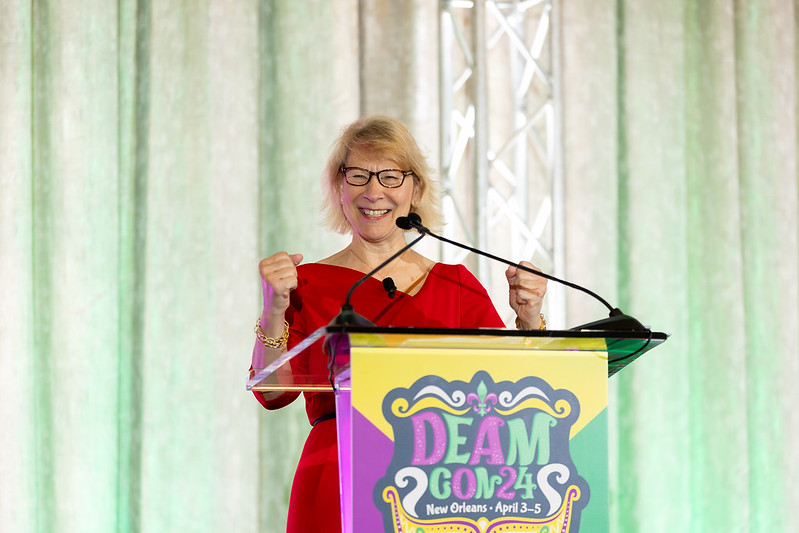
Providing a brief “snapshot” of the past year, Candee noted the OFCCP Week in Review blog, the DE Under 3 video recaps, the DE Talk Podcast, Recruit Rooster’s Talent Attract Video app, DE staff’s attendance at numerous industry events, DE virtual seminars, and DE’s town halls and surveys to gather Member feedback that informed DE comments to government agencies on important issues and developments.
Member Spotlight: Aligning Compliance and Recruitment Efforts
Mike Bazinet, the Director of Talent Acquisition at Affordable Care and a DE/Recruit Rooster Board Member, spoke from his over 26 years of recruiting experience in the military and corporate sectors about the relationship between a recruiter and a compliance expert. He addressed how to eliminate the disconnect that too often occurs between OFCCP compliance and recruitment.

“We realized that we cannot do this in a vacuum, and we had to work together … we needed to understand each other’s role and we needed to understand each other’s responsibilities,” Mike said. “When we realized that if we came together as one, we could crush it. And we did.”
Recruiters and compliance experts must develop the recruitment process together. For example, Mike discussed how they worked on creating disposition codes together that were meaningful to both recruiters and compliance experts. In addition, it is about “becoming efficient with how you work and how you do your job, and it is about outreach which is the fun part of recruiting,” Mike stated. “Get out from behind that desk,” and talk to people, he advised.
In doing so, recruiters will become well-rounded and more marketable, becoming expert sourcers who help make better quality hires. On the flip side, compliance experts will gain confidence in their recruitment processes, confidence in data management reports and techniques, improved documentation of marketing/outreach efforts, and successful audit outcomes.
Mike ended his remarks by encouraging the recruiters and compliance experts in attendance to talk with each other to gain improved insights into their roles.
Ellis & Lewis Discussed Continuing the Focus on Diversity, Equity, Inclusion & Belonging While Facing Setbacks
Returning to the DEAMcon stage following standout presentations at DEAMcon23 and DEAMcon22, Torin Ellis was joined by Miriam Lewis for a robust conversation about the challenges of diversity, equity, inclusion, and belonging (“DEIB”) efforts in 2024, acknowledging recent setbacks. Torin is the Diversity Strategist at The Torin Ellis Brand, and Miriam is the Chief Inclusion Officer at Principal Financial Group®.
Facing Resistance

Resistance is not necessarily an indication of racism/ill intent, both presenters agreed. “We cannot expect everybody to move at the same exact pace,” Torin noted. “We have to be able to be sensitive [and have] situational awareness, recognizing where we are inside of the organization,” he added.
Miriam reported that part of bringing people along on the journey at her current organization was arriving at a “shared definition of diversity, equity, and inclusion.” She continued:
“[W]e define diversity as everything that I am and more importantly everything that I am not. We want it to be a very humbling definition so that people understand that we need each other. That we cannot go on this journey by ourselves. And we define equity as giving people what they need to succeed, and we use examples like our on-site daycare center. People can easily get behind the fact that our on-site daycare center is not for everyone. It is for those who need it. And that equity works in that same way. And we defined inclusion as a deep sense of belonging or feeling at home and lastly, it is about how do we bring those three things together to create value for our organization. And not only creating value for our organization, making sure that our approach and strategy and everything that we do is tied back to how we are going to accelerate business growth and how we are going to increase business, as well as grow the business.”
Setbacks Along the Journey
Torin and Miriam acknowledged that missteps and setbacks happen. “We all make mistakes and typically it is not in the strategy, it is in the execution of the work itself,” Miriam observed. Communication in particular is where mistakes tend to occur, she said. She recommended that practitioners acknowledge mistakes and move forward, adding, “when we make mistakes, that is when we learn the most.” Embracing the lessons learned from mistakes “is really powerful,” she stated.
Torin then turned to an audio recording of a portion of his discussion at DEAMcon23 with Errin Braddock, VP & Chief Diversity Officer at Enterprise Holdings. In that segment, Errin discussed the difference between mere activity and actual progress:
“[…] I like to call it treadmill running. […] When I think of treadmills, that is to get me in shape and feel good. I see a lot of companies and people doing this treadmill running. That makes them feel really good. If we’re trying to get to the other end of that room, treadmill running won’t get you there. So, we really want to focus on what is the activity [that will get us there], not just on the treadmill. […] It has to be about progress. […] There is this activity versus progress, and we have to be focused on progress. […] I’ve had to slow people down and tell them you’re on the treadmill. Get off the treadmill. […] Trying to get people back to progress is a shift that we need to start going towards.”
“I am frustrated that in 2024 … Errin’s comment … still resonates because we are not pushing back on the insanity” and being accountable for advancing DEI, Torrin said, turning the discussion to examine the reasons behind this lack of progress.
“We put too much pressure on our talent acquisition function, and we do not hold leaders accountable for the equity and inclusion part of it, and that is where we are not able to retain talent,” Miriam stated.
Key Takeaways
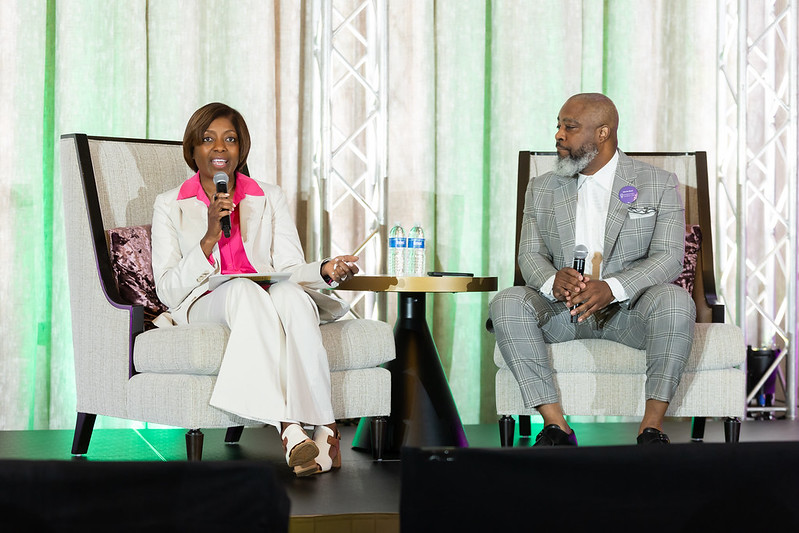
“A lot of what is happening today is a distraction. So, if you are not strategic and staying on strategy, you are going to wake up a year from now and be in the same place you were today. So, make sure that you are being intentional, that you are prioritizing for you and the resources, and make sure you are delivering on this work. The last thing you want to do is not make any progress because of what is going on externally. It is a distraction and we have to deal with some of it, but make sure that you have a person focused on dealing with that and what percentage of time you would have dealing with those issues or maybe even create a sub-team outside of your team to help with the work, but stay on strategy and make sure that you are intentional and make sure that you prioritize what is most important first.”
Torin noted three key concepts: empowerment, strategic exploration, and tactical execution. The application of each of these depends on what stage of the DEIB journey an organization and its leadership are in.
In addition, Torin mentioned the concept of “Covering” – which is when people downplay their differences to fit in and avoid penalties – and recommended a book by Kenji Yoshino that discusses it.
The presenters left the audience with the following concluding remarks:
Miriam: “Use your voice and stay the course.”
Torin: “What is needed is a shift in openness and value, given in the narratives by both the storytellers and the listeners.”
French Shared How Recruit Rooster’s Talent Attract App Helps Employers Navigate Veteran Recruitment & Retention
Heather Hoffman, Chief Operating Officer at Recruit Rooster by DE, introduced Marine veteran Kelly French, Veteran Talent Acquisition Program Specialist at United Rentals. Kelly is piloting a program to use Recruit Rooster’s Talent Attract Video platform as a veteran recruitment tool, Heather said. Kelly then shared his valuable insights into building a military-friendly employer brand.
Start Simply
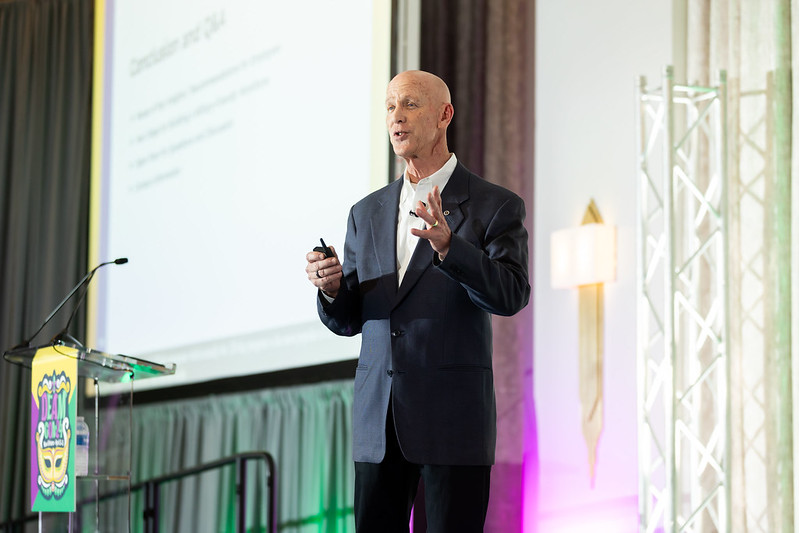
United Rentals mandates annual training for all recruiters, HR, and talent sources, and they continuously update this training to address emerging issues. “We teach them how to read through resumes and pick out relatable traits and skills and to create a synopsis to represent those skills along with the resume and feedback to the managers. Which is very helpful to [those] who may not understand all of the acronyms and different jobs that we have in the military,” Kelly reported.
“I also encourage you to set corporate goals” and “follow-up and work with those recruiters who are not hitting those goals and maybe provide some additional training opportunity,” Kelly said.
Provide a Range of Opportunities for Transition of Skills
United Rentals offers a variety of programs to proactively prepare veterans for a seamless civilian transition in the final six months of military service, Kelly stated. The company offers programs that start service members with a foundation to develop through various skilled trades including: Equipment Associate, Technician, Driver, Inside Sales, Operations, and Manager in Training roles. These programs include safety, equipment, and technical training; they also include on-the-job training and job rotations.
Veteran-Focused Career Website
Moreover, United Rentals has a veteran-focused career site, which features valuable tools such as a Military-to Civilian-Occupation Translator, Veteran Resources, and a Military Base jobs map for service members and their families to find career opportunities near whichever base they are located.
Veteran Talent Attract Video
Kelly described Recruit Rooster’s Talent Attract Video platform as “one of the most fun programs that I have had to work on.” This easy-to-use app allows veterans to capture testimonials about working for United Rentals right from their phones. Recruit Rooster’s creative team provides expert assistance to help with video editing and prompts. Noting that it is “super simple,” he then played a few of the testimonial videos that they created with the app.
To illustrate the process, he shared the following graphic:
“We are using something everybody probably has in their hand right now – their telephone,” Kelly said, noting the ease of downloading the app.
They selected six veterans to participate in the program and created six different topic points for them to select from. From that, they received 15 videos. Recruit Rooster’s Talent Attract team edited the videos and provided feedback and closed captioning. United Rentals plans to include some of these videos in a small library of eventually about 20 videos that they will rotate through their webpages to keep them fresh, Kelly reported.
“The editing crew did a fantastic job, and they are enabling us to not only embed them in our landing page, we can use them in social media and other venues,” Kelly said. “I highly recommend that you try the Talent Attract video application. It was wonderful!,” he enthused.
“When you have those types of things set up on your homepage, you are automatically inclusive of the veteran community” and “are communicating and representing opportunities specific to them,” Kelly said.
Fox and Chambers Discussed OFCCP in Transition & What It Means for Federal Contractors
Due to delays in budgeting and the reduction in agency funding levels (see our story here), OFCCP Deputy Director Tina Williams was not able to appear as originally planned. Consequently, DE Executive Director Candee Chambers and Attorney John C. Fox of Fox, Wang & Morgan P.C. provided an update regarding recent OFCCP activities and their implications for federal contractors.
I. What Is the Latest on OFCCP Audits of Supply & Service Contracts?

OFCCP released its most recent previous S&S CSAL in September 2023 (see our story here). Many establishments dropped off this list because they turned out not to be covered federal contractors, John reported. “They are also trying to audit establishments that were closed years ago,” Candee added.
In any event, “they are doing far fewer audits and so your likelihood of being selected is diminishing,” John told the audience.
Policy shift: OFCCP now auditing by type of contract, rather than contractor type. Next, the presenters discussed the OFCCP’s policy and operations shift (departing from 50 years of policy and practice) – announced last September via quietly published, extensive updates to its Frequently Asked Questions (“FAQs”) section covering CSALs – from auditing by “the type of contractor” a company is (Supply & Service Contractor v Construction Contractor) to auditing a company by the “type of contract” it signs. Accordingly, an S&S contractor with an S&S contract that is also signatory to a covered federal government construction contract could be subject to an audit of its S&S contract AND separately of its construction contract. (For more details on this policy change, see our story here.) Vice-versa, this also means that if an S&S contractor signs a “construction” contract, it must comply with OFCCP’s Construction Rules (16 Affirmative Action Steps listed at 41 CFR 60-4.3 (a) 7 (a-k)) as to its onsite construction employees and not OFCCP’s Rules for S&S contractors.
Prior to this policy change, a federal contractor was either an S&S contractor or a construction contractor, but “never both,” John explained. As a result of this change, OFCCP policy now expects many federal S&S contractors to comply with OFCCP’s Construction Rules (about which they are unlikely familiar) no matter how small a percentage of their business may involve a federal construction contract, and vice-versa.
Importantly, OFCCP made this policy shift absent the legally required Administrative Procedure Act public notice and comment procedures, Candee pointed out.
Moreover, putting aside OFCCP’s regulations, Executive Order 11246 itself is written so that once a company has one contract, it is obligated nationwide. This situation leaves contractors with a choice “to either comply or resist,” John said. “OFCCP is routinely rejecting the pleas of companies that say: “No, we are a construction contractor, we don’t want to do supply and service,” he reported.
“I would never go into an audit today without at least talking to [an] attorney ahead of time,” Candee observed, noting the complexity of the legal issues surrounding audits at this time.
Implications of new audit Scheduling Letter & Itemized Listing. The anticipated S&S CSAL coming up in May will be “the first time that everybody in the CSAL will be audited subject to OFCCP‘s new audit Scheduling Letter,” John pointed out. OFCCP’s latest, controversial revisions to its Supply & Service audit Scheduling Letter and Itemized Listing took effect on August 24, 2023. (See our stories here, here, and here for details on the changes to the Scheduling Letter and Itemized Listing).
The new OFCCP audit Scheduling Letter places greater emphasis on discrimination data collections at the Desk Audit stage of an investigation and increases a contractor’s response burden to the Itemized Listing (attached to the audit Scheduling Letter) by (according to OFCCP’s own admission) 25 percent (to almost 40 hours), but it is more likely by hundreds of hours, the presenters said. Despite this burden increase, contractors will still only have the 30 days to respond and supply the data demands. Accordingly, contractors who are on the CSAL will need to look at the current S&S audit Scheduling Letter and estimate how much time and resources it will take to respond.
Another layer of difficulty is that OFCCP is no longer operating under its long-standing policy of waiting 45 days after a CSAL announcement to begin sending audit Scheduling Letters. John reported that this became evident based on experiences with his clients and that OFCCP has not made any public announcement of this change in audit practice, but which change OFCCP is entitled to make.
John reminded the audience that during the Desk Audit stage of an OFCCP Compliance Audit, OFCCP is only entitled to obtain the information and data specified in the audit Scheduling Letter and Itemized Listing. “That is all they get. They do not have the right to send you an email asking for more stuff, nor does OFCCP have the right to call you on the phone and ask you for more stuff,” he said. Therefore, it is a policy choice for each contractor to decide whether they want to comply with OFCCP’s additional unauthorized requests at the Desk Audit stage.
However, not providing this additional information might put a contractor at risk of OFCCP moving on to the Onsite Investigation stage. No contractor wants that, Candee remarked. But OFCCP rarely comes onsite anymore, John reported.
II. What Is the Latest on OFCCP Audits of Construction Contracts?
Moving on to audits of Construction Contracts, the presenters again mentioned the OFCCP policy shift of OFCCP now auditing by contract type, rather than by type of contractor. As a result, OFCCP asserts that construction contractors with an S&S contract must now comply with OFCCP’s non-construction (i.e., S&S) Affirmative Action Rules as to the contractor’s employees who are not onsite construction employees. That includes developing written Affirmative Action Plans (“AAPs”) and conducting discrimination analyses.

The presenters also reported that, similar to the new S&S audit Scheduling Letter and Itemized Listing, OFCCP, in February 2024, published a proposal to revise its audit Scheduling Letter and Itemized Listing for Construction Contractors. (Our story here details that pending proposal.) As with the new S&S Scheduling Letter, OFCCP’s proposed Construction Contractor Scheduling Letter, if implemented, would place a greater emphasis on discrimination data collections at the Desk Audit stage of an investigation. In contrast to S&S audits, OFCCP “will also likely come on site a lot more frequently, I predict, as to construction contractors, because they are accustomed for the last 50 years to do a construction audit by immediately going on-site and never having the desk audit. And that will be a hard habit for OFCCP to lose,” John predicted.
Also, of note in the proposed Construction Contractor Scheduling Letter changes is its focus on tracking disparities in overtime. “Almost none of you document [overtime] at the end of every shift,” John cautioned the audience. At least develop a written policy of how overtime is to be administered in the field so your managers may be able to defend audits by noting their adherence to the policy to explain why a manger denied an onsite construction employee the privilege of working overtime on any particular shift during OFCCP’s two-year period of review prior to the date of its audit Scheduling Letter.
III. What does the new OMB Directive 15 (SPD-15) Mean for Federal Contractors?
At the end of March, the White House Office of Management and Budget (“OMB”) released its finalized revisions to its Statistical Policy Directive No. 15: Standards for Maintaining, Collecting, and Presenting Federal Data on Race and Ethnicity (“SPD 15”). SPD 15 contains common definitions to allow the federal government to compare race and what OMB calls “ethnicity” data across federal agencies. Federal contractors use SPD 15 primarily to identify the races and national origins of applicants and employees for use in AAPs and discrimination analyses. OMB directed the applicable federal agencies to implement program changes over the next 18 months, i.e., by the beginning of FY 2026 on October 1, 2025. (Our story here details those changes).
One Reporting Category OMB added was the Middle Eastern or North African (“MENA”) as a minimum reporting category, separate and distinct from the White category, Candee said, noting it will be interesting to see how many workers who have previously self-identified as White will use this new category instead.
While “[s]ome of those reporting categories are also protected groups,” contractors must be careful to not confuse “Reporting Categories” with “Protected Groups” for the purpose of AAPs and disparity discrimination analyses,” John cautioned. For example, “Two or More Races” and “MENA” are reporting categories, but NOT “Protected Groups.”
No “Protected Groups” have changed (that would take Congress passing a new statute), so nothing changes the columns and rows in contractor AAPs and Goals analyses, John advised. However, the revised SPD 15 has changed the definition of who fits into the specified racial categories a bit, he observed.
IV. What the New OFCCP Budget Means for Federal Contractors?
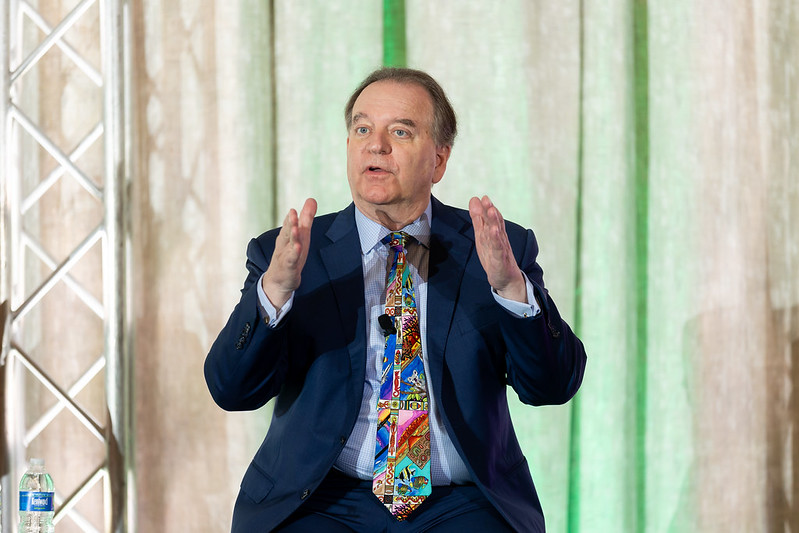
Consequently, OFCCP will have fewer employees over the course of the next 18 months due to increased payroll costs and inflation costs which collectively total over 10% in additional costs for both FY2024 and FY2025 which must be paid for out of the agency’s 24-month flat-lined budgets, John pointed out. It may also have to cut programs. The agency will have to attrit almost 20 employees by September 30, 2024, and attrit an additional approximately 50 employees to fit within these flatline budget allocations, he estimated.
“[It] will mean a lot fewer audits,” John predicted, “because they are not going to have the kind of horsepower they thought they had or were going to have.” Furthermore, in their budget justification for FY2025 (our story is here), OFCCP told the Congress that the reason they were so slow to close audits was because they have been hiring new staff and retraining existing staff, “and this high turnover was bleeding a lot of the agency’s resources,” John said. Now they are going to have to cut down on all this staffing, he added.
V. The Coming Presidential Election Could Have Meaning For OFCCP
“We will see a monstrous change one way or the other this coming January, and it will all be about the budget,” John said. All 435 seats in the House of Representatives are up for grabs as well as 33 Senate seats (currently held by 20 Democrats and 10 Republicans). “In fiscal year 2026, that 2023 budget deal freezing budgets for two years (for FY2024 and FY2025) for the federal non-defense agencies will be off the table. The President or whoever is sitting in [the Oval] Office may then suggest a higher or lower budget. Then we will have to see what Congress is willing to agree with,” he added.
Regardless of who wins the White House, the party that controls the House and the Senate will determine who will control the federal budget and whether the “rugby scrum” of the last four years will continue, John noted. He explained that the budget is the key to successful agency policy programs, and it has been the vehicle to change policy by what does, or does not, get funded. (Also see our stories here and here.)
Also factoring into these budget concerns are three reports issued by the U.S. Government Accountability Office (“GAO”) in mid-February (our detailed story is here). The GAO concluded that the national debt is “unsustainable,” and “there is no economist that thinks this can go on,” John pointed out. Therefore, budget cuts and tax increases will be major issues regardless of who is in the White House or Congress.
Notably, two key Senators – Democrat Joe Manchin (WV) and Independent Krysten Sinema (AZ) – “have elected to not join the political scrum this year” (i.e., they are not running for reelection), Candee observed.
With declining resources, “OFCCP is a vulnerable agency at this point,” John stated. “It is a very tiny agency in the scheme of things, and they are about as thin as they can go.” Accordingly, budget determinations are vital to the agency’s existence.
Lewis & O’Hara-Harvey Explored the Equity Essentials
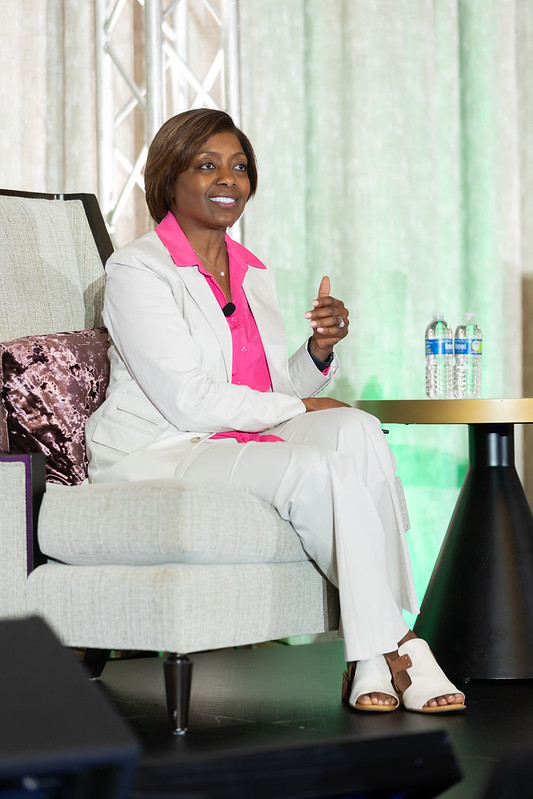
Principal Financial Group® is a global organization that does business in 80 different markets,” Miriam explained. We have nearly 20,000 employees and 62 million customers. “We make sure that inclusion is a part of both our business and people processes,” she said.
Foundations
Miriam said that their foundation of trust and inclusion is the five following contract statements that participants agree to in just about every corporate meeting:
- Connect and work together towards shared goals.
- Communicate openly and listen to understand. Include all perspectives and mitigate biases. “It’s not just good enough to have a seat at the table. We want to make sure you have a voice at the table,” Miriam stated.
- Tone and words matter. Respectfully challenge your own and each other’s thinking.
- Agree to apologize, forgive, fix, and move forward. We are all human and know that mistakes happen.
- Act, support, and hold each other accountable.
Next, they went over Deloitte’s D&I Maturity Model, noting that the stages are a continuous build. “We don’t stop doing one when you move to the next level; you continue to do all of them,” Miriam instructed.
DEI professionals do this work not only because it is the right thing to do, but also because it is the profitable thing to do, Miriam pointed out. “These are the tailwinds that can help to accelerate business growth and to help make us a more profitable company,” she said.
This effort is not based only on the work that Miriam and Julie do, Miriam pointed out. “It has to be attached to almost every employee in the organization,” she said, noting that they have an “inclusion ecosystem.” This system includes employees, cross-functional leadership, employee resource groups, relevant committees (covering social and environmental issues), and the community.
Defining Diversity, Equity & Inclusion
Miriam shared how they define DEI:
Diversity is everything I am, and everything I’m not.
Equity focuses on removing barriers and giving people what they need to succeed.
Inclusion is a deep sense of belonging or feeling at home.
In the context of equity, Miriam noted the concept of “Covering,” to which she and Torin Ellis alluded in their presentation earlier that morning. Covering is when people downplay their differences to fit in and avoid penalties. “We’re not getting the best out of our employees if they’re having to cover, if they are not able to be themselves in meetings,” she said.
“There are five predominant biases that show up in the workplace,” Miriam said, introducing the acronym “SEEDS,” as illustrated by the NeuroLeadership Institute. “The first one is Similarity bias. The second is Expedience. The third is Experience. The fourth is Distance and the last is the Safety bias.” This common framework helps make it easy to interrupt a conversation “to make sure that the bias isn’t running the show,” she noted.
Accountability
Continuous assessment and monitoring of your program is essential, Julie advised. “We don’t want [it] just to be a robotic process,” she said. To that end, companies should do a deeper dive into their data. For example, they look at performance ratings, promotions, compensation, hires, transfers, and other measures of how the company is developing people. “We also look at opportunities that are being afforded across the board,” she stated.
Moreover, while DEI professionals may think their programs are effective, it is important to check the pulse of the company’s workforce, Julie pointed out. Accordingly, they survey their workforce regularly.
Data to Support & Assess Efforts
“A lot of the anti-DEI work [that exists] is because we don’t have the data to support the work that we’re doing and many times we don’t know what we’re trying to achieve in this work,” Miriam observed. Therefore, it’s important to get and share the data illustrating your progress. They share relevant, aggregated data with both employees and clients, she reported.
“Being on strategy and making sure that we make informed decisions around this data is extremely important and it also helps us to make sure that we are not advancing diversity, equity, and inclusion at the expense of any other group,” she said.
Cappfinity Outlined Adoption and Conversion to a Skills-Based Employee Hiring and Development System
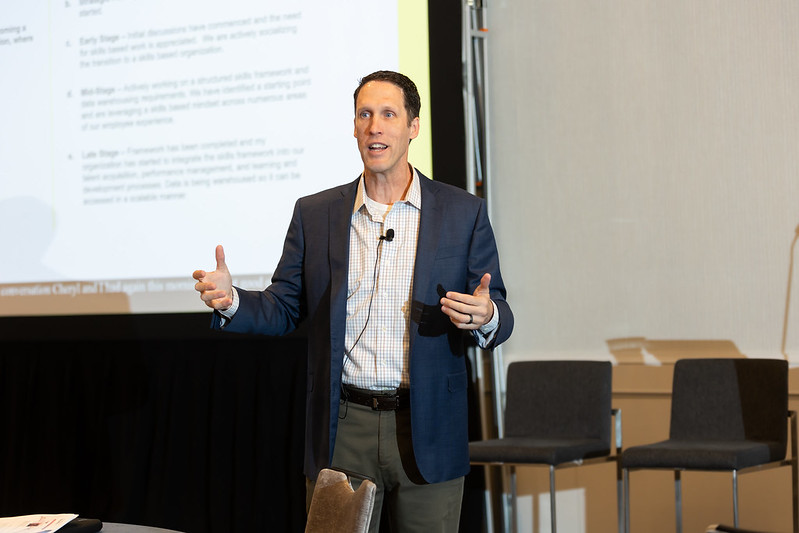
Stephen and Ilona gave us a “whistle-stop tour” to develop the foundations of a skilled-based organization consisting of three primary components:
- defining, measuring, developing, and warehousing skill needs;
- creating a “skills framework;” and
- “building a business case” to transition to skills-based selections for hire and the development of employees.
NOTABLE QUOTES:
“I do believe that skills are the new talent currency. I believe that organizations and individuals who get this right, who figure out how to unearth someone’s skills, figure out a way to talk about someone’s potential, someone’s capabilities, the things that someone can do, wants to do, has energy around doing, and matching them to the needs of the business, matching them to the business results and outcomes, those are the true constituents that are going to be the most successful in all of this.” (Ilona)
“If your company is used to using competencies, all we’re doing is moving knowledge out of the way and moving ability out of the way. We’re just focused on the skills.” (Stephen)
“Have you ever lost a project manager? You didn’t lose the project manager. You lost this many skills. That’s what you lost. And this many skills can be broken down into technical, cognitive, behavioral. So, we’d posit you’re not losing a job title, you’re losing a set of 30 skills that you don’t know that person had.” … “The problem is you lost this many skills, and if you don’t know what those skills were, you can’t replace them.” (Stephen)
“If you just want a starting point, in how to transition to a skills-based organization,” Stephen recommended you start with what he called the “three pillars”: “define, measure and develop.” (Stephen)
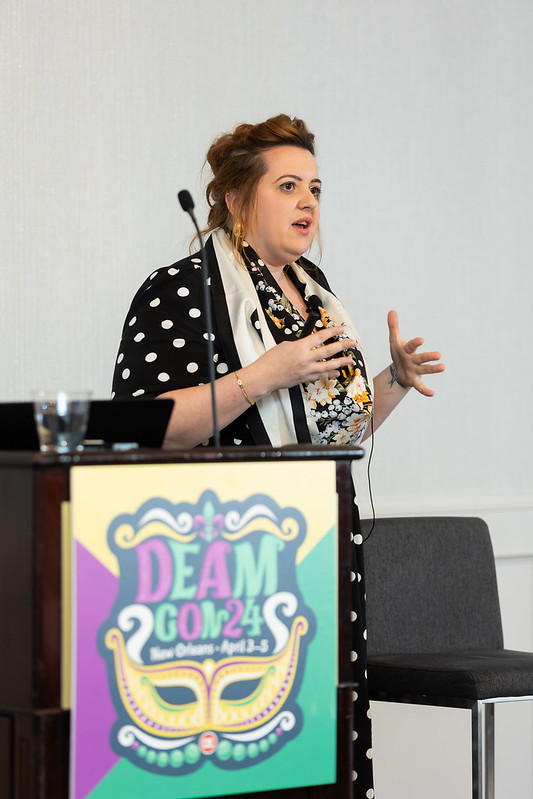
Cappfinity employs 180 professionals worldwide who it believes have driven it to be the global leader measuring and developing potential in Talent Acquisition and Talent Management by delivering new data-driven measurable leadership and development solutions.
Campbell Discussed Going Beyond Race & Gender to Create a More Equitable, Inclusive Culture
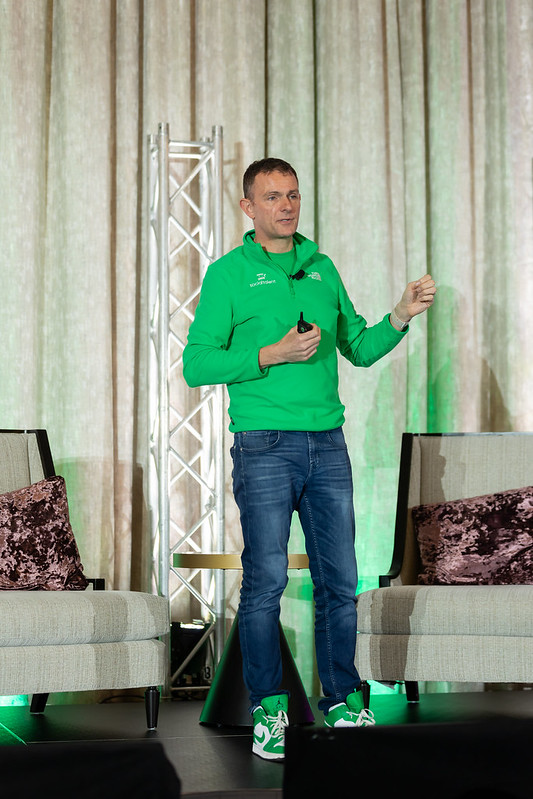
Focusing on Just Race or Gender Tends to Be Polarizing
In the United States, Western Europe, and Africa, race and gender tend to be the top areas of DEI focus, Johnny reported. However, in the Middle East or Eastern Europe, their number one issue is age or generational differences, while in South America the top DEI priority is disabilities.
While “gender and race are extremely important topics to focus on,” focusing on those topics alone leads to an “Us versus Them” mentality, he said. Gender and race by definition are typically quite polarizing, he explained, noting that many people look at DEI efforts as “something for other people” and not about them. Johnny stated that there is less DEI pullback outside of the United States “because as you move outside the U.S., you tend to see more focus on a broader range of differences.”
A More Holistic Approach to DEI Brings More People In
“What you want to try to do is break down those barriers,” Johnny stated. “You want to make sure that most people are seeing the employee base as a large ‘Us,’” he advised.
So, how can you turn “Thems” into “Us-es”? “When your DEI efforts are not just about one or two issues … [y]ou tend to find nearly everybody in the organization is included in one of those differences and the intersectionality is likely to mean they are included in many of them,” he noted. For example, “[w]hile you may be a white male like me, you might have a disability. You might be neurodivergent. You might look to try to protect your faith within that organization. You might be conscious of your age differences in the organization,” he illustrated.
“It’s much easier to be an “Us” when you have a broader definition of DEI in your organization and we see this across the world,” Johnny said.
While building on using a broader focus, “it’s also really important to try to take someone else’s perspective,” he advised. “We do this by individuating somebody. When we see somebody who, apparently, has an immediate difference, it is much easier to make them an ‘Us’” when we consider points in common, he explained. Examples of such points may include: (1) do they like the same pets? (2) do they love their kids? (3) do they have a sick parent as you do? (4) do they enjoy the same food(s), entertainment, or hobbies? When we individuate people, “we bond with them a lot more,” Johnny said. Accordingly, giving people enough contact with each other to individuate, turns “Thems” into “Us-es.”
In contrast, “trying to change “Thems” into “Us-es” by using rational arguments does not work,” he noted. “You tend to find the opposite happens. People become more polarized. They become more firm in their differences and opinions of difference as well.”
Empathy Is the Bedrock
A lot of this work is challenging in situations where an organization does not have a very diverse workforce, Johnny pointed out. This is where empathy comes in. “We are trying to build empathy and understanding to try to individuate everybody else in the organization that might be considered [a] ‘Them’ to somebody and try to make that person see ‘Them’ as ‘Us.’”
Storytelling Is How You Develop Empathy: Ideas Stick to Stories
“Emotional stimulation is the foundation for empathy,” Johnny continued, and we stimulate emotions through effective storytelling. Good storytelling releases a chemical in the body that renders a person more likely to feel empathy and understanding for somebody else, he said. “That is critical to develop more inclusion in our organizations. More understanding of other people in the organization and their challenges, their differences, advantages, and benefits to working together.”
To illustrate this point, he shared a video his friend Lucy Sheen made in 2020 to address common misconceptions in the United Kingdom surrounding the causes of COVID-19; that video is titled “I AM NOT A VIRUS.”
“Something like that is much more powerful than reading about statistics, reading educational material, or reading about my unconscious bias,” Johnny stated. “Facts don’t really change people’s minds … The power is trying to tap into human emotion, to tap into empathy as the foundation and how to change people’s minds and how to get them to work together.”
“We are hardwired to remember stories, not facts,” he added later in the presentation.
You MUST Put the Policies and Processes in Place, Otherwise Awareness Is Not Enough
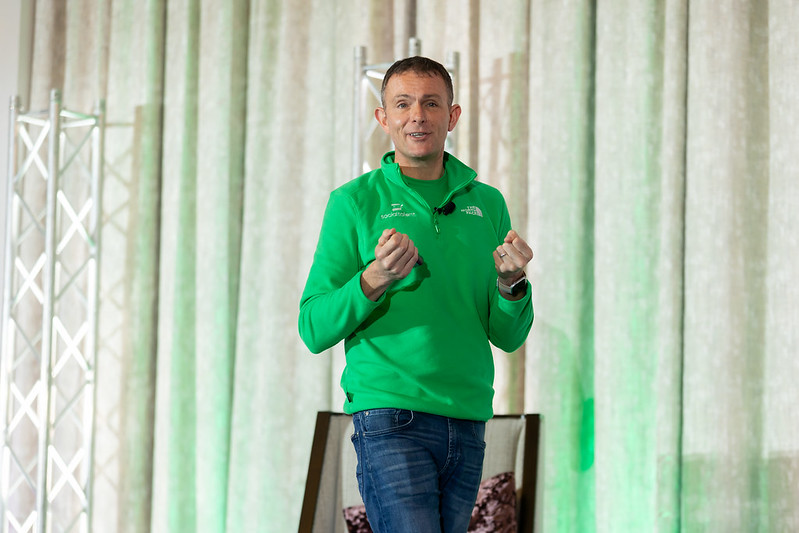
Putting policies and processes in place is essential. “Otherwise, awareness just is not enough,” he said. “It’s not the sexy part but you’ve got to make sure the policies match what you’re trying to do on the other side.”
A lot of organizations get in trouble because they jump to practices without establishing the foundation of empathy and policies and processes, he noted. Having all three levels in place is “changing the cultural fabric” of an organization, he said.
Educate Your Workforce on The Practices That Strengthen Inclusion
“Most people want to do this [DEI]. They want to do right,” Johnny said. “If you create empathy and understanding and begin to bring in policies, people want to know what to do.” However, “they are terrified to ask you how to do it. Particularly if you have some sort of job title that includes DEI because you are the police to them. They are terrified of your judgment because they acknowledge to themselves privately they are ignorant as to what to do.” Without education, people will tend to “put [their] head in the sand and move on.”
Support Through Year-Long Storytelling That Leverages Empathy
Organizations can support their efforts through year-long storytelling that leverages empathy by looking for events and opportunities that happen throughout the year to support various diverse communities.
“You don’t need to have all the answers; you need to be the person who asks great questions and can synthesize those answers,” Johnny said.
The Walsh Group Explained the Nuts and Bolts of Starting a Veterans ERG Leveraged by DE’s Partner Relationship Tool
Chris Lawrence from The Walsh Group explained that Walsh is a construction company with 8,000 employees widely dispersed throughout the United States. Walsh and its subsidiary corporations finance, build, outfit, operate, and maintain the full lifecycle of major bridge and infrastructure construction projects nationwide and in Canada. Chris discussed the organizational challenges that Walsh, as a construction company, had attracting veterans, people with disabilities, women, and minorities, and why he thought that using Walsh’s Veteran employee resources group (“ERG”) enhanced Walsh’s abilities to recruit veterans.
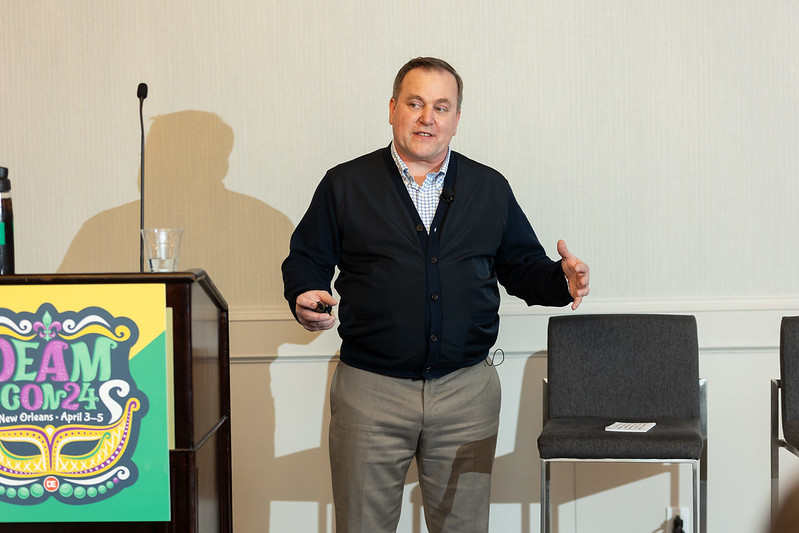
Chris, a military veteran himself, explained the importance of recruiting veterans with someone who understands military culture: “The culture I came out of in the military was really important to me because I wanted to be part of someplace that speaks to me and the values that I have.” He further emphasized that “it’s getting those recruiters understanding that there are skills and experiences that people in the military have that are intangible that you don’t really understand.” But Chris served as a bridge between TA and Walsh’s Veterans ERG to let TA know “our ERG members can help you navigate and understand what they’re trying to say,” which is especially important since so many veterans are comfortable with dozens of acronyms unique to military service.
He also reported that company recruiting and compliance personnel need to study their recruitment data to determine whether they are being effective, both for HR reasons and to satisfy federal regulatory compliance obligations. “And the nice thing is the DirectEmployers’ PRM [Partner Relationship Manager] tool that gives you a metric of how effective the partners you’re working with are and whether you are able to actually recruit from them. The PRM also helps us with our compliance programs for Section 503. The PRM gives you the ability to annually assess your recruitment sources.”
Chris also explained how he uses the PRM to automate the delivery of available Walsh jobs to local veterans’ groups while throwing out a nice shoutout to DirectEmployers Member Engagement representative Tammy Huff:
“Finally, DirectEmployers provides its Member companies with a partner relationship tool that allows you to create the roles you want for your organization and to assign them to whoever you want. So, this is an example in South Dakota, in Rapid City. We were working on an Air Force base and our local veteran wanted to partner with a military group there. He became a (Walsh) Ambassador to this group to recruit both military members and their spouses and within the veteran community. And you can actually utilize the DE PRM tool to actually send jobs to them on a periodic basis. Tammy Huff with DirectEmployers, she was incredibly helpful. Your DE Membership gives you the ability for her to give you customized services. Tammy set up a whole training program for us and explained how to implement a lot of DE tools throughout our enterprise and how to use them effectively to help us recruit veterans and other candidates from other diversity groups.”
How to Start a Veterans ERG
Chris reported that he is a firm believer that each employee group in search of becoming an ERG needs an “executive sponsor”:
“You need somebody that’s going to push this from a leadership standpoint. If you had somebody in HR who can help support the group, and the group wanted to go in a certain direction, you might be able to make it work. But without any kind of executive support or HR support, I can’t imagine how the ERG group is going to be effective without somebody leading it.”
Here is Chris’ sage “been there, done that” advice about how to get going both externally and internally:
“I got Walsh involved with Student Veterans of America. One May, during military appreciation month, we also put a bunch of flyers on every board we had out there on our construction sites and encouraged people to join our Veterans ERG. Part of the problem that we had is our trade individuals are not issued email addresses from the Walsh Group. They don’t all work on computers. They work as laborers, as machine operators, whatever.
So we thought it was going to be a challenge, but I simply created a QR code in Qualtrics that our employees could scan and allow them to become a member of the Veterans ERG. Then I was able to use whatever email they wanted me to use to celebrate their military birthdays with them. Each military member has a service birthday which we use to send a message out to our veterans on their service birthday. We can also send out alerts and create camaraderie. We also conceived of and created an electronic flip book with a page for each veteran as a way for them to tell their story and to build camaraderie. We publish the Veterans flip book every November 11th. This is yet another way for us to honor the veterans within our community.
We have struggled to get trade members to join. I think they think that they will be forced to attend training seminars and things of that nature. Again, we make it so that that’s not what this is organized around. And we do listen. We published a Qualtrics survey asking our Veteran ERG members what they wanted their employee resource group to do. I’m there to help support them. But I don’t lead it. This has to be employee-driven and I’ll be there to assist them. But I can’t lead everything. They’ve got to take the initiative and lead it where they want to go.
So, what we did was we put the word out there. We’d like to organize a resource group. Then we’d like you to tell us what you want the employee resource group to focus on? And how do you want to proceed? What they decided was recruitment. And that’s how we put together this program and decided, okay, this is how we’re going to create an ambassador program. So, we sent out an email asking would you like to become a Walsh Group “Ambassador” and work with your local military organizations?
As another example of building Veteran camaraderie, our Veterans in Indianapolis host a tournament every year where they bring their families together and play that cornhole thing. And they just get together and they just do fun things as a veteran’s group. So, it’s a way for us to be involved in the community, to have them represent the Walsh Group in their community and to build those relationships. It’s really just taking the initiative to say we want to start this group and then find out from the employee voice, where do you want this group to go?”
Chris also explained what NOT to do:
“I was at (a large International) bank that started an employee resource group. Unfortunately, however, the diversity and inclusion department took over and said, oh, we’re going to focus on professional training, and it was all leadership stuff. And the veterans said, you know, I don’t want to do that. If it’s not something the employees want to be involved in, you’re just ticking off boxes. And that’s not why we want to do this.”
Full Circle Compliance: Using DE Partnerships to Supercharge
Recruitment & DEI Efforts
While conducting outreach with organizations that serve veterans, individuals with disabilities and underserved communities is essential for meeting federal contractor compliance obligations, most organizations strive to go beyond that as they work to build diverse and inclusive workforces that thrive. Shannon Offord, VP of Strategic Partnerships & Alliances at DE, and Michael (Mike) Witt, Community & State Outreach Manager at DE discussed how DE’s Partner Relationship Manager (“PRM”) tool, when used strategically and with intention, helps build lasting connections that fulfill both legal compliance obligations while also propelling an organization’s DEI movement forward.
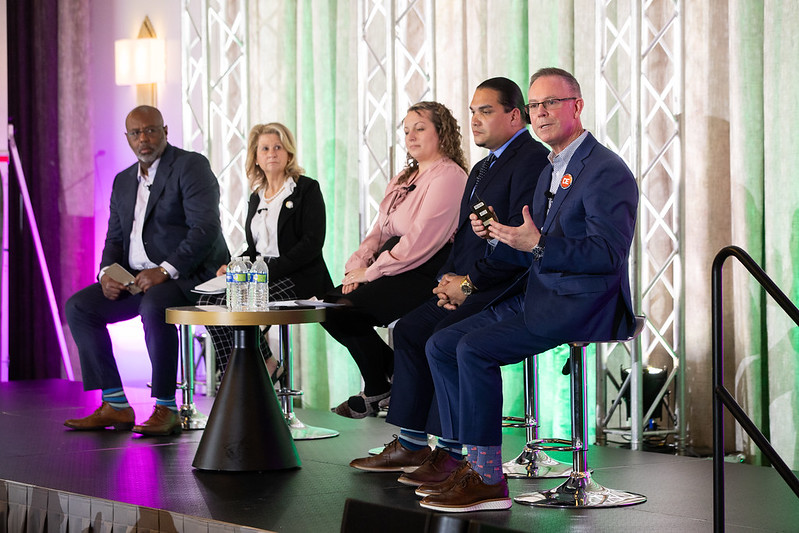
“The benefit of outreach comes in the relationships that you build,” Mike said. “A lot of our partners have other resources [beyond recruitment and diversity] that can help you to build and expand your business,” he continued.
Mike shared a slide to note the following ways that relationships can expand your recruitment:
- Tap into diverse talent pools
- Have partners reaching out to you with qualified candidates
- Influence training programs and services
- Learn about new ways to attract talent
- Solve challenges together
- Connect with other resources for your company
Next, Shannon and Mike introduced three of DE’s partners to share how they used the PRM to build relationships.
As a Statewide Local Veterans Employment Representative (“LVER”) at the Washington Employment Security Department, Hannah Schoepp works with the development agencies around Washington State to coordinate their roles. Her department also partners with neighboring states in Idaho and Oregon as well. She provided two examples of how her agency used partnerships to connect veteran job seekers to employers and veterans’ services.
The PRM currently has just over 115 LVERs, like Hannah, for employers to reach out to build relationships and partnerships, Mike said.
Karen Melikant is the National Business Solutions Manager at EQUUS Workforce Solutions. EQUUS operates in 34 states in 350 locations and assists over one million individuals every year to pursue education, training, and employment goals. EQUUS is also an industry intermediary, under contract with the U.S. Department of Labor, that provides information and technical assistance to help educational institutions, employers, sponsors, stakeholders, and workforce system partners to develop or expand a Registered Apprenticeship.
“When you talk about building a relationship or partnership with an employer, you have to understand their company, mission, and their culture which ensures we are able to provide customized solutions to meet talent needs,” Karen said. Their team of trained business solutions consultants, and career transition professionals, work with business survey organizations and thousands of companies to understand the specific workforce needs, priorities, and company culture. “We do this by meeting with company representatives, either by phone, in person or virtually, to develop a comprehensive business needs assessment. And an employer profile on each one of our business clients. This information is then used to form the design, recruitment, and retention strategies and prepare our candidates,” she explained. As I result, they successfully connect qualified candidates to career opportunities while working to support retention and career advancement.
Alberto Maldonado is a Regional Director of Business Development at Volunteers of America and is based in Puerto Rico. Groups they serve include elderly men and women returning from prison, homeless individuals, families, people with disabilities, and those recovering from addiction. He talked about using the PRM to make connections and develop relationships to help the people they serve.
“This is a game-changer for us” in providing employment options for their clients, Alberto said.
Generational Expert Gwoke’s Keynote Focused on Recruiting & Retaining Millennial Employees

Generations in the Workforce & Their Communication Styles
“Many times, I talk to people my age or older who are frustrated” in their efforts to communicate with young people, Phil noted. “At the same time, I talk to emerging professionals, and they say, Phil, I’m trying to get my message out.”
Phil showed the audience a chart describing the shift from one generation to the next. The years noted are not intended to be precise, he explained. The generations are:
- Baby Boomers (born between 1946 and 1964);
- Generation X (born between 1965 and 1979);
- Millennials (born between 1980 and 1995; and
- Gen Z (born between 1996 and 2010).
Phil explained how a person’s teenage years form core beliefs about right, wrong, religion, politics, truth, type of career, pursuing the duties of that career, and what words are inappropriate to say or inappropriate in the workplace. As an example, he discussed how the different generations communicated with friends in their teenage years, and how that shaped their communication styles.
Baby Boomers used rotary dial telephones. Because of the effort involved in using these devices and the lack of messaging tools such as voice mail, Baby Boomers “learned to put more time into that phone call,” Phil said. “People would make an appointment just to connect with their friend,” and “this generation learned the importance of punctuality.”
Generation X spent their formative years using pagers and answering machines with a short capacity for message length. Consequently, Gen Xers learned to communicate in a manner that is “short, sweet, and to the point,” Phil observed. Baby Boomers tend to view this communication style as unprofessional, while Millennials tend to view it as aggressive or even hostile. “They say stop attacking me. That’s not our intention. We are just very efficient with our time,” he explained.
Millennials are the first generation in history with access to cell phones in large numbers in their teenage years. That meant they could bypass their parental gatekeepers, who enforced phone etiquette rules, and call their friends directly. Thereby, Millennials learned to always be their authentic selves and came to the workforce using that casual language. “People my age and older lost our minds,” Phil joked.
Gen Z came up in the age of smartphones, which enabled them, for the first time in human history, to have a written conversation in real time with another human being. As a result, the rules for writing are changing quickly. For instance, Gen Z view periods in text messages as low-key hostile or otherwise unfriendly.
“To me what diversity is, is different perspectives as a result of the unique set of experiences,” Phil stated. “Be curious, not cautious. Understand why this person views the world as they do,” he advised.
“My definition of inclusion,” he continued, “is an internal belief that by adding unique experiences around me, that brings valuable things to my life.”
Generational Values
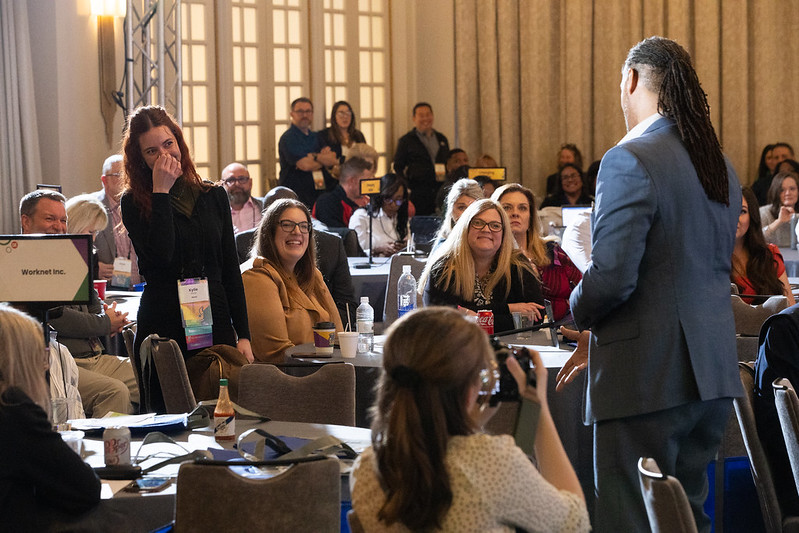
Baby Boomers are about change – when they perceive the value of it. “They changed every stage of life they have gone through,” he said.
Gen Xers grew up in an environment where they were confronted with harsh reality and very little cushioning or sugar-coating. Society essentially said, “let’s be real with these kids.” As a result, Xers have a self-reliant mindset. When life gets hard, they “will just find a way to get through,” Phil stated.
Millennials have a different mindset. Phil described it as: “There’s got to be a better way we can do things around here. And can we get a little flexibility as to when we get things done?”
“For many Millennials, their pursuit of new opportunities is asking the question, how can I be the best or better version of myself? How can I upgrade?” Phil explained. They are used to rapidly changing technology and always looking forward to something new. “
Gen Z is far more empathetic to mental health and the needs that exist there, Phil pointed out, noting how they came up during the COVID-19 pandemic. He cited research showing that GenZ is yearning for more human connection. “Turns out, the more high-tech our society becomes, the more its citizens long for touch,” he observed. Most Gen Zers want to work in teams versus independently.
Focus on Gen Z
Gen Z “are used to being told exactly what it means to be successful,” Phil advised. Research shows that 76 percent of Gen Z members believe they should be promoted within a year of starting their first job. While this is probably not realistic in most cases, employers should offer Gen Z members “a roadmap of success that is very detailed” in six-month increments, based on obtaining new skills, he suggested. Map out what it looks like to grow in their position every year, providing tangible benchmarks and specific information.
Phil cited another survey showing that Gen Zers “just want to know that people are proud of the work that they are doing.”
Day 1 Recap
THIS COLUMN IS MEANT TO ASSIST IN A GENERAL UNDERSTANDING OF THE CURRENT LAW AND PRACTICE RELATING TO OFCCP. IT IS NOT TO BE REGARDED AS LEGAL ADVICE. COMPANIES OR INDIVIDUALS WITH PARTICULAR QUESTIONS SHOULD SEEK ADVICE OF COUNSEL.
SUBSCRIBE.
Subscribe to receive alerts, news and updates on all things related to OFCCP compliance as it applies to federal contractors.
OFCCP Compliance Text Alerts
Get OFCCP compliance alerts on your cell phone. Text the word compliance to 18668693326 and confirm your subscription. Provider message and data rates may apply.

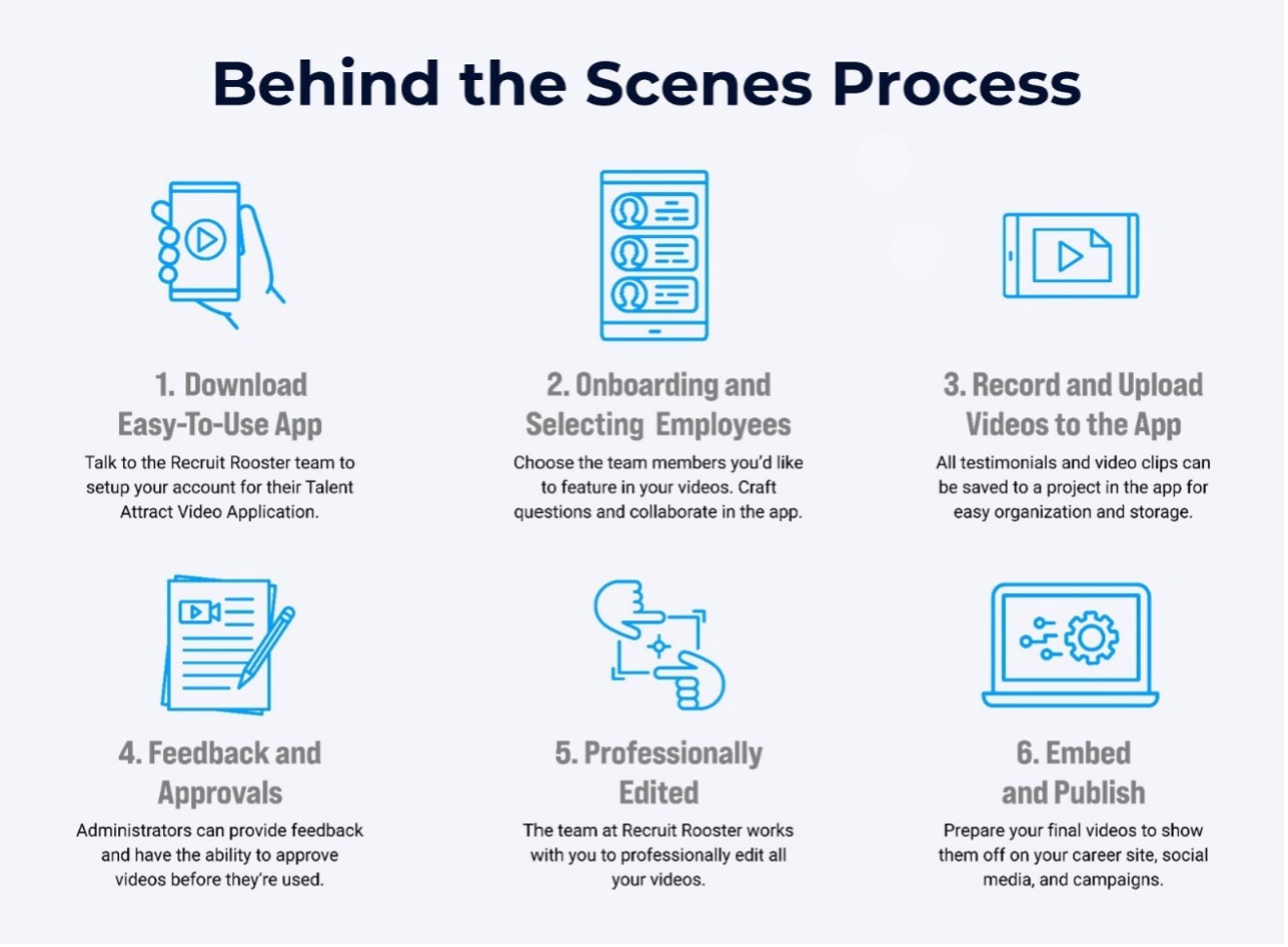
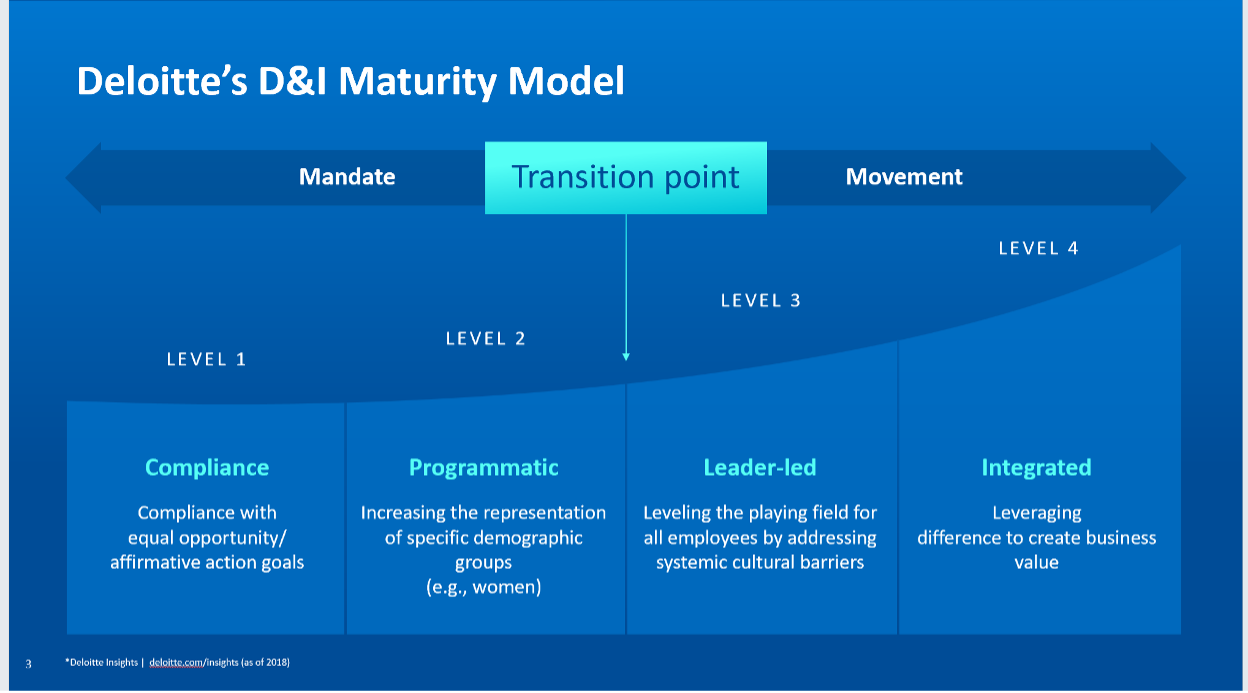
 Continuous assessment and monitoring of your program is essential, Julie advised. “We don’t want [it] just to be a robotic process,” she said. To that end, companies should do a deeper dive into their data. For example, they look at performance ratings, promotions, compensation, hires, transfers, and other measures of how the company is developing people. “We also look at opportunities that are being afforded across the board,” she stated.
Continuous assessment and monitoring of your program is essential, Julie advised. “We don’t want [it] just to be a robotic process,” she said. To that end, companies should do a deeper dive into their data. For example, they look at performance ratings, promotions, compensation, hires, transfers, and other measures of how the company is developing people. “We also look at opportunities that are being afforded across the board,” she stated.